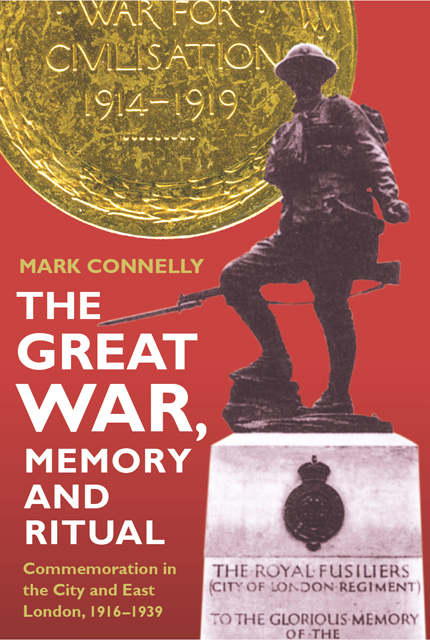5 - Civic War Memorials: Public Pride and Private Grief
Published online by Cambridge University Press: 22 March 2023
Summary
The City of London
The City of London erected two great military memorials, one for the Royal Regiment of Fusiliers and one in memory of all the London Troops. The latter was instigated by the Lord Mayor, Sir Horace Brooks Marshall, in May 1919 and as such can be seen as the official civic response of the City. Brooks Marshall was maintaining the City's role as leader of the capital; further, by suggesting the space in front of the Royal Exchange as the site for the memorial, he chose the economic heart of the empire as the fitting place to honour the men of the capital. Sir Aston Webb was invited to design a suitable memorial and in June 1919 he presented his original plans. He advocated two 75ft flag masts for flying the Royal Standard and the City pennant. The flag bases themselves were to be engraved with figures of Victory and Peace. Webb mixed the practical with the truly monumental:
It was felt that no finer site could be found for such a memorial in London, and the form chosen was selected because the ground space occupied by such a memorial is sufficiently small to offer little or no obstruction to the traffic here, while however crowded the space in front of the Exchange may be, this memorial, owing to its height, will always be visible and easily distinguished from any other memorial in London, as a reminder of the great deeds of the men of the London Regiments.
It was a peculiarly apt design for the City was copying a great trading empire of the past: Leopardi executed three flag masts for St Mark's Square, Venice in 1505.
The Royal Fusiliers also broached the subject of a war memorial in June 1919. A number of practical schemes were suggested, but the Regimental War Memorial Committee decided ‘that it is not possible at the present time, when so many deserving institutions such as hospitals, are in serious mone- tary difficulties, to raise sufficient funds to found and endow a club or similar institution'. Eventually they accepted the advice of the sculptor Sir George Frampton and approached his ex-pupil, Albert Toft, who was duly commissioned to design a suitable memorial.
Both schemes then ran into difficulties. The court of common council declined to give Webb permission to erect his memorial according to the design submitted.
- Type
- Chapter
- Information
- The Great War, Memory and RitualCommemoration in the City and East London, 1916-1939, pp. 98 - 136Publisher: Boydell & BrewerPrint publication year: 2001

